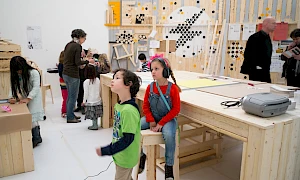Back to the Future. Confessions of the Imperfect: 1848 - 1989 - Today
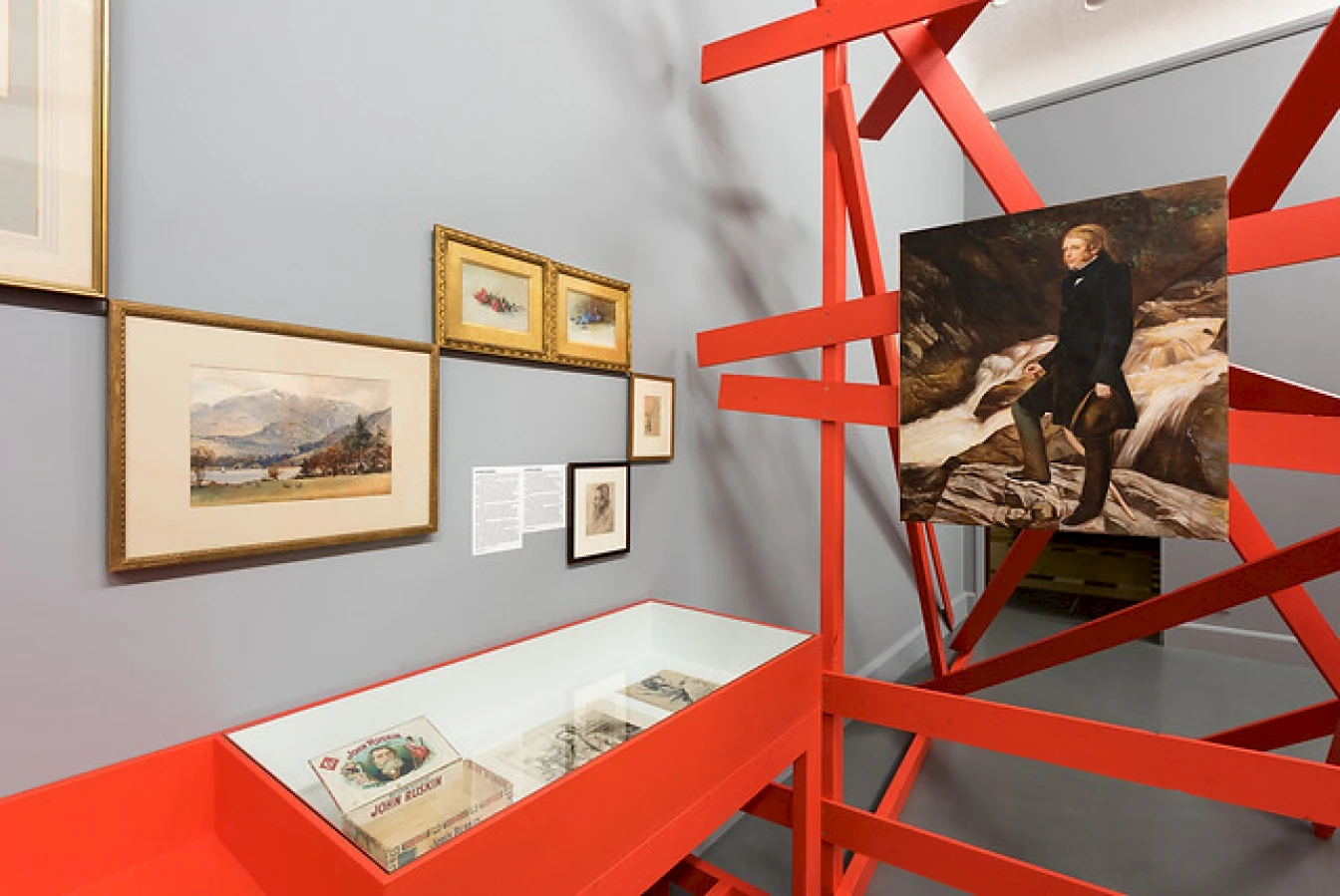
'Barricade of 1848' including Cheng Young Bin, Portrait of John Ruskin After John Everett Milais 1854-55, 2014, and Liam Gillick’s Barricade. Photo: Peter Cox.
In 1878 the American painter James McNeill Whistler famously sued the critic, theorist and philanthropist John Ruskin for libel. A year earlier, Ruskin had written a review in which he accused Whistler of simply "flinging a pot of paint in the public's face". (Ruskin 1891, p. 79) Ruskin lost the case and was subsequently cast by history as reactionary – a kind of Victorian King Canute, attempting to turn back the incoming tide of self-referential and autonomous modern art. However, for the exhibition Confessions of the Imperfect: 1848 – 1989 – Today, curated by Steven ten Thije and Alistair Hudson at the Van Abbemuseum in 2014/ 2015, Ruskin provides a rhetorical figure through which neo-conservative reconstructions of history, as well as neo-liberal reconstructions of work and labour, can be challenged and re-imagined. More specifically, Confessions of the Imperfect re-uses Ruskin's role as an activist in early workers' education movements, or 'Mechanics' Institutes' as they were called, as a means to re-imagine a future in which art could play an integral role in learning and social improvement.
In order to do this, the exhibition takes its starting point from one of Ruskin's key texts, The Stones of Venice (originally published in three volumes between 1851-3), in which he argued that the flaws, lapses and imperfections evident in medieval architecture made it superior to the geometrical symmetry of its Renaissance successor. For Ruskin, this evidence of human endeavour and struggle, the very activity of reaching out for new solutions, is somehow embodied within the fault lines of visible labour or craft. As he put it, and as the first introductory wall text to the Confessions of the Imperfect exhibition re-states: "[...] we may expect that the first two elements of good architecture should be expressive of some great truths [...] the confession of imperfection and the confession of the Desire of Change."
As indicated in this statement (written some 20 years before his famous court case with Whistler), the rapid industrialisation of Europe, and its concomitant forms of alienated labour and reified reproduction, were already creating the conditions for the West to imagine the necessity of autonomous art. Ruskin's championing of the imperfect in medieval architecture, on the other hand, began to offer a way of thinking through alternatives to the moral and ethical paucity of a newly mechanised and commodified world order. Put simply, Ruskin saw no real alternative in the idea of an art for art's sake that was shorn off from the social and economic conditions of its own production. In light of this, Confessions of the Imperfect asks us to suspend our commonly held belief that Ruskin merely represents a conservative and backward-looking blockage in the inevitable flow of art's self-referential teleology. Instead, the exhibition invites us to imagine a world in which art had played an integrated role in the production of civic self-identity and the vision of a truly democratic public sphere. By setting the stage in this way, Confessions of the Imperfect presents itself with a dual historical and epistemological task. On one hand, it seeks to redress a commonly accepted art historical narrative by proposing a speculative alternative – what would have happened if Ruskin had won the 1878 court case against Whistler? What would have happened if, at this juncture, art had turned left instead of right? On the other, the exhibition begins to exert a certain kind of pressure on its own possibilities of realisation – how to present a speculative and alternative chronology of artworks, which require concomitant forms of alternative and speculative reading or usership, within the inescapably neo-Kantian logic of the museum space.1
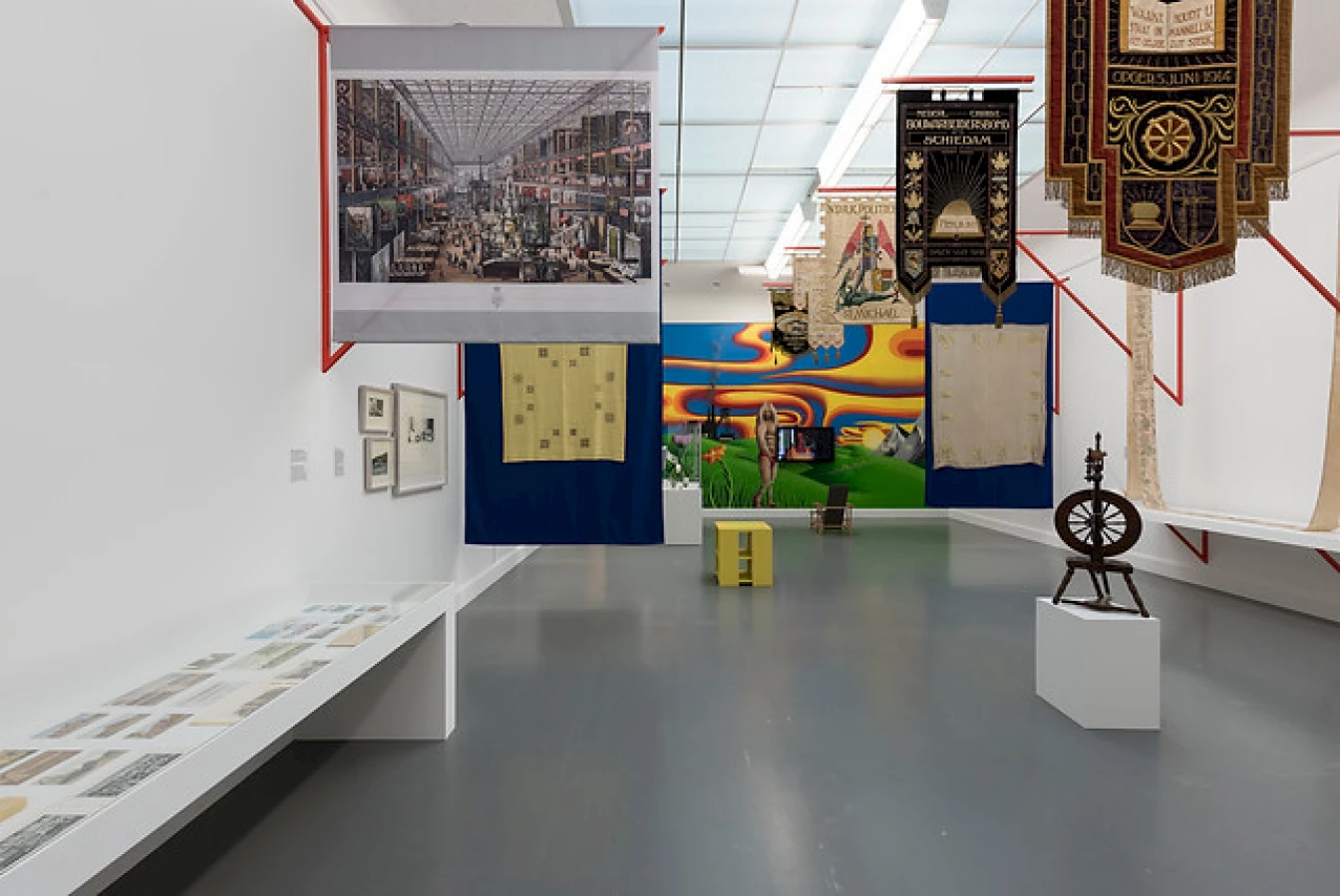
‘Barricade of Vista': including banners from the Dutch trade unions and Deller’s film So Many Ways to Hurt You. The Life and Times of Adrian Street, 2010. Photo: Peter Cox.
The way in which Confessions of the Imperfect chooses to undertake this task is by using the physical and metaphorical vehicle of the 'barricade' – represented by Liam Gillick's "architectural intervention" – as a through-line that loosely conjoins a constellation of smaller barricades and sites of occupation. As such, Gillick's barricade re-appears in several guises throughout the exhibition – from physical barrier, to performance platform, to modulated shelving units – and acts as a constant reminder of the iconic French barricades of 1848, through and across which the politics of the people were made manifest in revolution. In this sense the barricade also acts as a refrain, or a circulatory device, leading us through the blockades, divisions, caesuras and ideological networks of choice and refusal that inscribe our current environment of networked globalisation. The exhibition begins with the 'Barricade of 1848' in which Ruskin's own alternative perspectives – of a world where art would play a necessary and integrated role in the ongoing production of knowledge – are set out through examples of his own work and his belief in the 'Mechanics' Institutes' as an alternative source of rounded education. This is followed by the 'Barricade of Vista' which reminds us that many accepted museological forms of display and interpretation arose out of the West's nineteenth century preoccupation with World Fairs (such as the Great Exhibition of 1851 in London) and their foregrounding of art, science and innovation, alongside commerce and colonial expansion, as means to self-consciously develop new forms of modern national identity. Utopic social projects such as Lord Leverhulme's late nineteenth century construction of Port Sunlight in the UK (an ideal garden village for the workers of his Sunlight Soap Factory, built around a public museum and gallery) act as a context for more contemporary inheritors of useful art, such as Fernando García-Dory's Cheese Production Mobile Unit of 2011,2 banners from Jeremy Deller and Alan Kane's 2005 Folk Archive and Deller's 2010 film So Many Ways to Hurt You. The Life and Times of Adrian Street. Both the 'Barricade of 1848' and the 'Barricade of Vista' also closely reference the ongoing work of Grizedale Arts in the UK, and especially their re-purposing of the Coniston Institute along its original Ruskinian lines, through their insistence that the artists they work with simply do something 'useful'.3
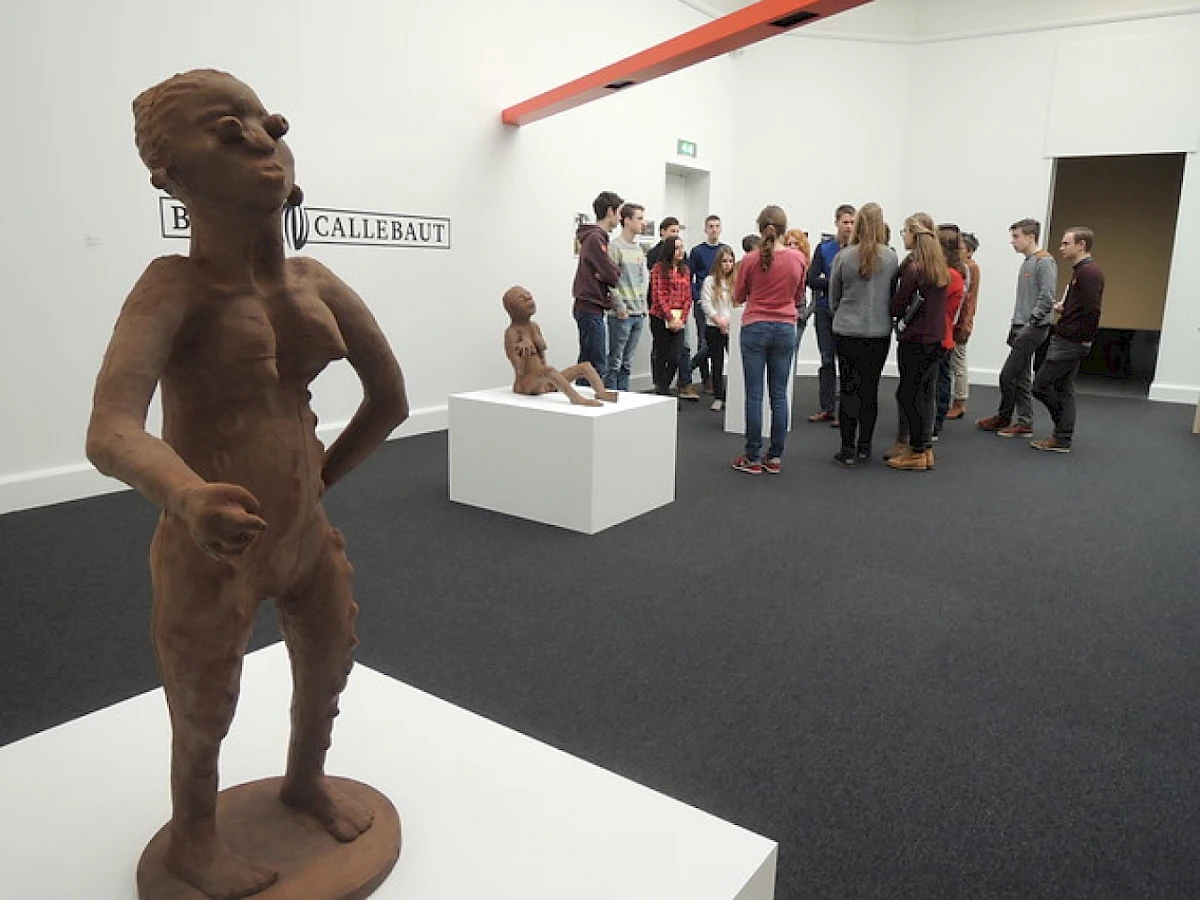
'Barricade of Discourse': Renzo Martens, Chocolate Sculpture from Institute for Human Activities, 2012-ongoing, detail. Photo: Peter Cox.
In the subsequent 'Barricade of Discourse', Renzo Martens' Institute for Human Activities (2012-ongoing)4 attempts to use the global systems of the contemporary art market (and the colonial legacy of modern art's appropriation of African culture) as a means to economically reclaim a now defunct Leverhulme Palm Plantation in the Democratic Republic of the Congo. Shown alongside Li Mu's 2013 propositions for re-using works in the Van Abbemuseum collection as useful objects for the Chinese village of Quizhuang, Martens' chocolate sculptures (from casts of models made by Congolese villagers which were then reproduced in Europe via 3D printing) remind us of the problematic historical and geographical proximity of networked globalisation. More specifically, Martens' and Mu's uses of art re-consider how our networked systems of communication can still act as both barrier, and facilitator, to participation and the right to speak. In contrast, the living legacy of utopic solutions to globalised late capitalism, introduced in the 'Barricade of Vista', is foregrounded again in Wendelien van Oldenborgh's 2014 Beauty and the Right to Remain Ugly. Using interviews with former residents of Eindhoven's Karregat project (a 1970s 'community without walls' experiment by the architect Frans van Klingeren, which has now become a Lidl supermarket), Oldenborgh's three-channel video installation attempts to re-plot a narrative of autonomous self-governance through the ruptures, proximities, lapses and folds of economic determinism. However, rather than simply seeing failure in this project, Oldenborgh's film traces a life-changing experience whose implications still echo as both an urban myth and a proposition for the future in Eindhoven and beyond.
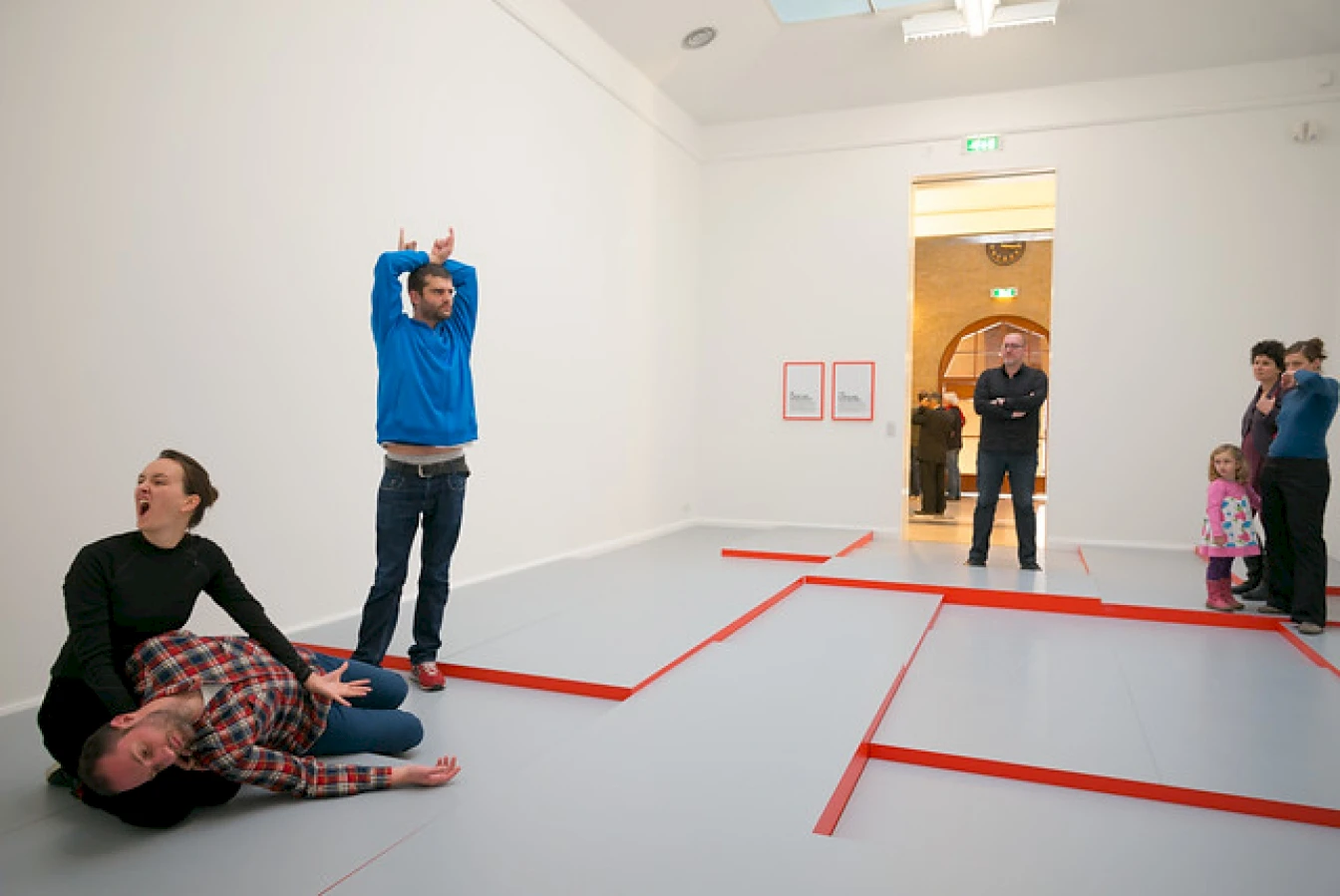
'Barricade of the Suppressed': including Guernica as performed by Alexandra Pirici and Manuel Pelmuş. Photo: Peter Cox.
Continuing along the lines of the urge to re-invent the past, the 'Barricade of the Suppressed' uses Alexandra Pirici and Manuel Pelmuş's 2014 Public Collection of Modern Art, a collection of pysical and performative enactments of artworks, as a means to cast doubt on the status of the art object as both inheritor and incubator of cultural legacy. The 'Barricade of Light' considers the utopian role played by the concept of the modern city in twentieth century architectural solutions to living. The historical lineage of the city as gesamtkunstwerk, or total work of art, is traced as far back as Saint Bonaventure's thirteenth century treaties on light as the basis for an all-encompassing aesthetic theory (Saint Bonaventure 1257).
Penultimately, the 'Barricade of Stock' confronts the globalised overdependence on the exponential excess of both commodity form and information exchange. In this context, Antoni Miralda's 2014 installation Power Food Canbarricade, which offers a seemingly endless bank of energy drinks from around the world with names such as 'Cocaine', 'Missile', 'Superman' and 'Cannabis', becomes a clear parody of the neo-liberal mantra of standardised, prepackaged and commodified 'self-help' solutions. On the other hand, Paul's Kimchi Co which, as part of Static's Noodlebar project (2008-ongoing), seeks to provide the grounds for a standalone franchise business to be developed by local residents, foregrounds current debates about the possible roles and functions that artists and museums could play together in developing new ways of living. Both these works are reminders of our increasing dependence on stock to make sense of ourselves and a world that is somehow always beyond our grasp – a world which seems to be continually in excess of our ability to comprehend, analyse or account.
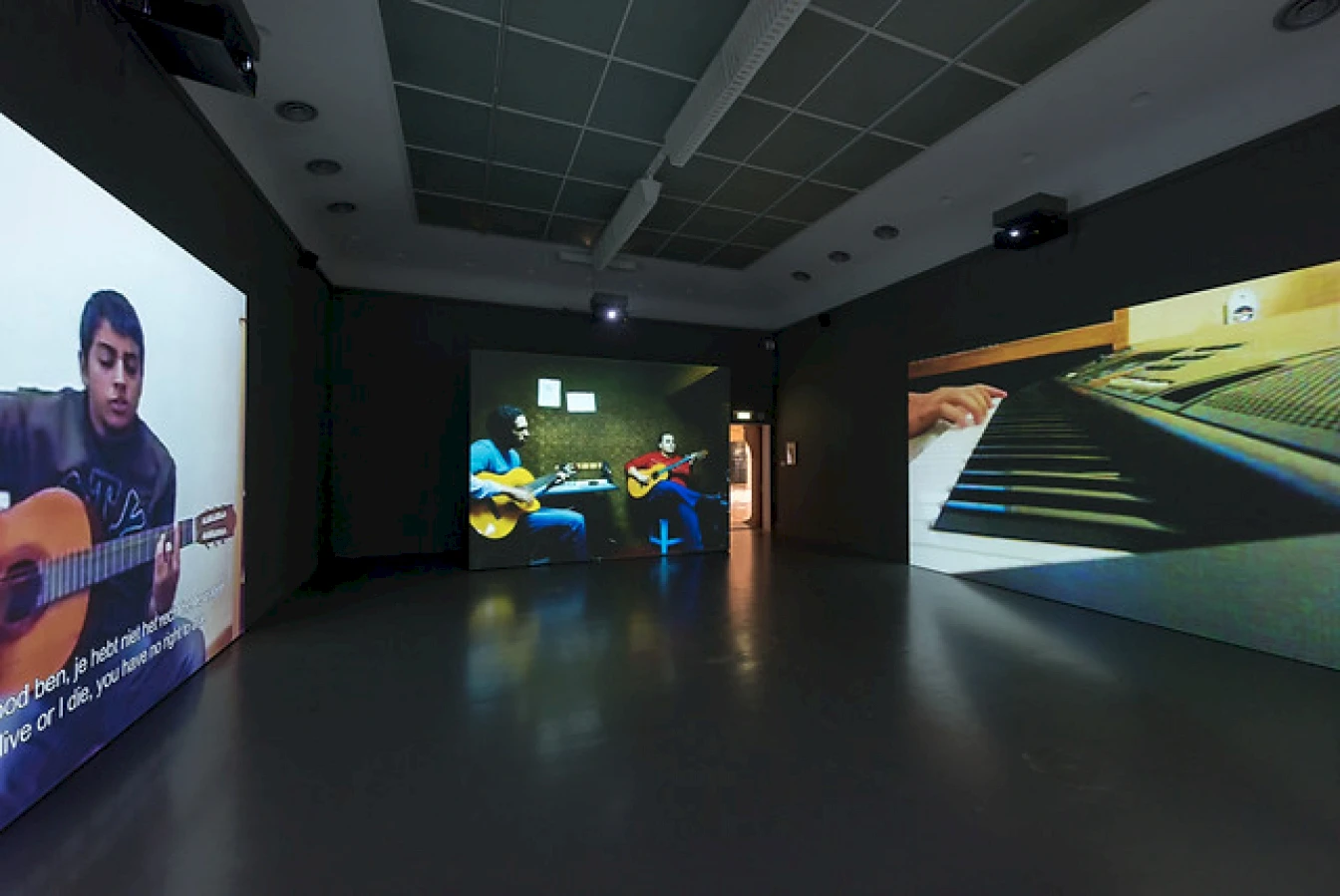
‘Barricade of Data': Akram Zaatari’s four-channel video installation Dance to the End of Love, 2010. Photo: Peter Cox.
Finally, in 'The Barricade of Data', Akram Zaatari's 2011 four-channel video installation Dance to the End of Love, which uses YouTube clips of people making their own culture, is placed alongside the small but incredibly significant 1876 gouache by John Ruskin entitled Map Showing the Physical Geography of Palestine. It is, perhaps above all else, the tension that exists between these two final artworks – one contemporary, the other a historical anachronism, one emblematic of the borderless surplus of global information exchange, the other of the cartographic will of Western colonialism to quantify and contain what it could never begin to understand – that the truly radical potentiality of Confessions of the Imperfect begins to open up. This potential is to be found both in the intentional and unintentional conflicts that Confessions of the Imperfect manifests, in the gaps, lapses, frustrations, obfuscations and inevitable imperfections of the exhibition format within which it finds itself both embodied and embalmed.
Acting as an historical prequel to the Van Abbemuseum's Museum of Arte Útil (Aikens 2015), and also as a set of suggestions beyond, Confessions of the Imperfect can only be truly activated if one continues to propagate, and also to accept and adopt, the problematic category of the participatory 'user' as posited by Stephen Wright in his corresponding publication Toward a Lexicon of Usership (Wright 2014, footnote 2). However, the prevailing condition of museum architecture within a spectacular attention economy – accepted forms of exhibition, display, engagement and their concomitant ideology of mediation (which, in its currently outmoded form, exists somewhere between the public will to spread the 'word of art' and the commercial imperative to statistically cultivate an increasingly disinterested and alienated audience) – currently militate against the ambitions of exhibitions such as Confessions of the Imperfect and host institutions such as the Van Abbemuseum in a number of crucial ways.
Most obvious, as has already been pointed out by Nick Aikens in his review of The Museum of Arte Útil (Aikens 2015), is the dialectical problematic of bringing into the museum the kinds of work which were never really intended for that context in the first place. Seeing such work as documentary evidence – and simply accepting the museum's metonymic role as collator of partial remnants and artefacts – leaves users currently without the tools necessary to interpret and interact (let alone to activate) those works. Confessions of the Imperfect points towards the pressing need to develop radically new forms of living activism within galleries and museums themselves – and this can only be achieved by developing and negotiating new and overlapping roles for curators, artists, artworks and users. Only then will a familiar kind of topological Venn diagram – in which the categories of curator, artist, artwork and user may seem to mutate in new ways whilst, in reality, remaining ontologically secure – finally give way to a truly rhyzomatic possibility of reconstruction and change.
Somewhat less obviously, though related at every level, is the struggle that Confessions of the Imperfect has with the task of re-purposing the museum and gallery as a site for propositions of the new. In order to deploy its complex message, and to allow users to unlock and activate its radical potential, Confessions of the Imperfect is forced to use a lot of explanatory text (which is often relegated to the format of title cards), whilst its two 'class rooms', one dedicated to 1848 and the other to 1989, were largely dormant. Could these spaces, which were primarily intended for local schools to use, have also been used to engage visitors in dialogues and discussions about the exhibition? Or as hubs where users, invited guests and museum staff speculate on connections made between different propositions and works in the exhibition? And what of the legacy of this exhibition? Will it continue to exist online as an ongoing interactive educational platform or will it simply be recorded, documented and archived?
Whilst Confessions of the Imperfect clearly calls for new ways of using art as a tool for rethinking our lives, it is equally clear that it fails in any attempt to break out of the neo-Kantian architecture of autonomous experience and disinterested spectatorship that it seeks to critique. But in so doing, in taking upon itself a task it could never hope to achieve, Confessions of the Imperfect is at its most useful. It embodies, perhaps more than it intended, Ruskin's plea to use architecture as a means to confess imperfection and to manifest a desire for change. By taking us back to the future, by allowing us to re-imagine ways in which art could have been, and could still be, used otherwise, Confessions of the Imperfect also reminds us that Immanuel Kant's initial idea of the aesthetic was to provide the Enlightenment subject with the means to imagine a future sense of its own resolved fulfilment – a fulfilment that could only be reached within a communal polity that was yet to be. If this is the case, then the job or work of the future museum must remain one that is manifestly aware of its own key responsibility – that of re-setting the terms and conditions of its own, and our, shared potential. This, of course, is a tall order. But it is one that L'Internationale, via the 'mediation' strand of The Uses of Art – The Legacy of 1848 and 1989 is attempting to address. Indeed, L'Internationale is working on a series of shows, events and happenings in 2017 which will be proposed, developed and co-produced with existing constituent members, stakeholders and users of the museums involved. This, in itself, is a bold move. It is clear, from the outset, that this will be a difficult, precarious and potentially factious process – one that will necessitate that the members of L'Internationale scrutinise and re-think their actual structures and feedback-loops of knowledge production and dissemination. But if we are to collectively confess the current imperfections of our procedures, undertaking such a process may offer one of the few remaining ways of going back to our future; of truly manifesting a realistic and achievable desire to change.
Bibliography
Aikens, N. 2015, "The Use of History and the Histories of Use: Museum of Arte Útil and Really Useful Knowledge", L'Internationale Online, January, viewed 17 March 2015.
Byrne, J. 2014, "Back to the Future: Grizedale Arts, Use Value and the Work of Art", The New Mechanics Library, Grizedale Arts, Coniston, viewed 17 March 2015.
Hudson, A. 2011, "The New Mechanics", in B. Ciric and S. Lai (eds.), Institution for the Future, Chinese Art Centre, Manchester. Also available online: The New Mechanics Library, Grizedale Arts, Coniston, viewed 17 March 2015.
Ruskin, J. 1851-1853, The Stones of Venice, 3 volumes, Smith, Elder & Co., London.
Ruskin, J. 1891, "Life Guards of New Life", July 1877, Letter 79, Fors Clavigera: Letters to the Workmen and Labourers of Great Britain, Volume the Fourth, Reuwee, Whattley and Walsh, Philadelphia, viewed 17 March 2015.
Saint Bonaventure, 1257, "On Retracing the Arts to Theology", made available online by The New Mechanics Library, Grizedale Arts, Coniston, viewed 17 March 2015.
Wright, S. 2013, Toward a Lexicon of Usership, Van Abbemuseum, Eindhoven. Also available online, viewed 7 March 2025.
